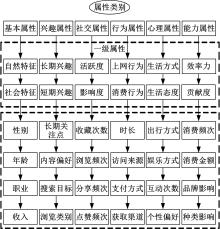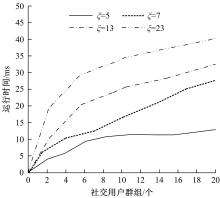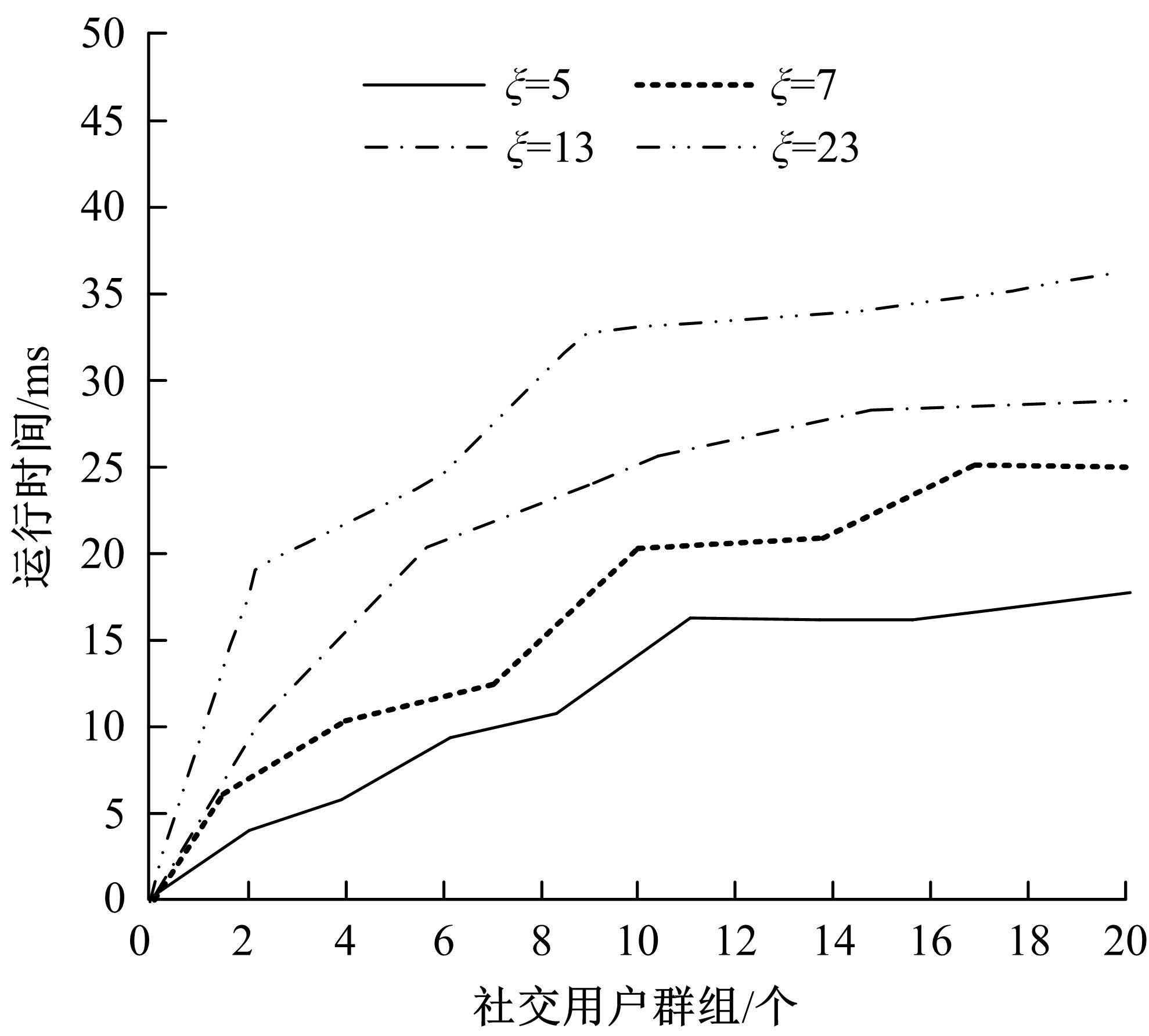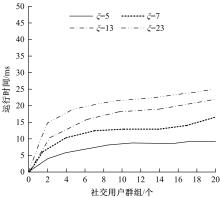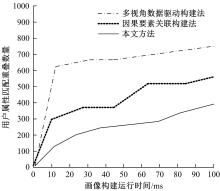Journal of Jilin University(Engineering and Technology Edition) ›› 2022, Vol. 52 ›› Issue (12): 2947-2953.doi: 10.13229/j.cnki.jdxbgxb20210884
Previous Articles Next Articles
Multi⁃grained social network user portrait construction method based on knowledge graph
Cai-mao LI( ),Shao-fan CHEN(
),Shao-fan CHEN( ),Cheng-rong LIN,Hao LIN,Qiu-hong CHEN
),Cheng-rong LIN,Hao LIN,Qiu-hong CHEN
- School of Computer Science and Technology,Hainan University,Haikou 570228,China
CLC Number:
- TP18
| 1 | 张艳丰,彭丽徽,洪闯,等. 因果要素关联视域下社交媒体倦怠用户画像模型构建[J]. 图书情报工作,2019, 63(14): 94-100. |
| Zhang Yan-feng, Peng Li-hui, Hong Chuang, et al. Construction of user portrait model of social media burnout from the perspective of causal factor association[J]. Library and Information Service Work, 2019,63(14): 94-100. | |
| 2 | 陈烨,陈天雨,董庆兴. 多视角数据驱动的社会化问答平台用户画像构建模型研究[J]. 图书情报知识,2019, 37(5): 64-72. |
| Chen Ye, Chen Tian-yu, Dong Qing-xing. Research on the model construction of multi-view-data-driven user profile for social Q&A platform[J]. Book and Intelligence Knowledge, 2019, 37(5): 64-72. | |
| 3 | Ruan Q, Wu Q, Wang Y, et al. Effective learning model of user classification based on ensemble learning algorithms[J]. Computing,2019, 101(6): 531-545. |
| 4 | 许力分,倪志伟,朱旭辉,等. 融合基于mapreduce并行改进二元蚁群算法与分形维数的属性选择方法[J]. 系统科学与数学, 2019, 39(6): 918-933. |
| Xu Li-fen, Ni Zhi-wei, Zhu Xu-hui, et al. Attribute selection method combined with mapreduce-based improved BACO and fractal dimension[J]. Journal of Systems Science and Mathematical Sciences,2019,39(6):918-933. | |
| 5 | 刘小洋,唐婷,何道兵. 融合社交网络用户自身属性的信息传播数学建模与舆情演化分析[J]. 中文信息学报, 2019, 33(9): 115-122. |
| Liu Xiao-yang, Tang Ting, He Dao-bing. Mathematical modeling and public opinion evolution analysis of information diffusion with the user attributes[J]. Journal of Chinese Information Processing,2019,33(9): 115-122. | |
| 6 | 李飞. 全渠道客户旅程体验图——基于用户画像、客户体验图和客户旅程图的整合研究[J]. 技术经济,2019,38(5):46-56. |
| Li Fei. Omni-channel oustomer journey experience map: integration research based on personas, customer experience map and customer journey map[J]. Technology Economics, 2019, 38(5): 46-56. | |
| 7 | 郑源,陈品祥,冯学兵,等. 北京房地产新政下的房地产市场特点研究——基于不动产登记的用户画像[J]. 测绘通报,2019():176-180. |
| Zheng Yuan, Chen Pin-xiang, Feng Xue-bing, et al. Real estate market characteristics under beijing new real estate policy——based on real estate registration[J]. Mapping Bulletin, 2019(Sup.2): 176-180. | |
| 8 | 孙铁柱,田琳. 基于CRT分类算法的用户画像分层模型——以银行借贷用户为例[J]. 情报科学, 2020,38(9): 75-81. |
| Sun Tie-zhu, Tian Lin. Model of user layered profile based on CRT classification algorithm——taking loan users of bank as an example[J]. Intelligence Science,2020,38(9): 75-81. | |
| 9 | 张宜浩,朱小飞,徐传运,等. 基于用户评论的深度情感分析和多视图协同融合的混合推荐方法[J]. 计算机学报, 2019, 42(6): 1316-1333. |
| Zhang Yi-hao, Zhu Xiao-fei, Xu Chuan-yun, et al. Hybrid recommendation approach based on deep sentiment analysis of user reviews and multi-view collaborative fusion[J]. Chinese Journal of Computers, 2019,42(6): 1316-1333. | |
| 10 | 张大勇,许磊,孔洪新. 社交媒体用户群体互动行为特征研究——以微信用户群分享为例[J]. 情报理论与实践, 2019, 42(10): 97-101, 116. |
| Zhang Da-yong, Xu Lei, Kong Hong-xin. Users' interaction behavior characteristics of social media: an exploration of wechat group's sharing behavior[J]. Information Studies: Theory & Application, 2019, 42(10): 97-101, 116. | |
| 11 | 吴晓,王凌瑾,宁昱西,等. 从社交网络到地理网络——基于南京市高校新浪微博用户的分析[J]. 经济地理, 2020, 40(4): 83-95. |
| Wu Xiao, Wang Ling-jin, Ning Yu-xi, et al. From social network to geographical network: a case study of college Sina weibo users in Nanjing[J]. Economic Geography,2020,40(4):83-95. | |
| 12 | 张敏军,华庆一. 基于概率矩阵分解算法的社交网络用户兴趣点个性化推荐[J].计算机科学,2020, 47(12):144-148. |
| Zhang Min-jun, Hua Qing-yi. Personalized recommendation of social network users'interest points based on probability matrix decomposition algorithm[J]. Computer Science,2020,47(12):144-148. | |
| 13 | 杨玉仁,张书奎,龙浩,等. 群智感知中基于社交属性及有效用户计算的任务分发机制[J]. 计算机应用研究,2019,36(5):1493-1499. |
| Yang Yu-ren, Zhang Shu-kui, Long Hao, et al. Task distribution mechanism based on social attribute and effective user calculation in crowd sensing [J]. Application Research of Computers,2019,36(5): 1493-1499. | |
| 14 | 周效章. 高校数字资源社会化服务的用户需求属性分析——基于Kano模型[J].情报杂志,2019,38(10):200-207. |
| Zhou Xiao-zhang. Attributes of user's demand of the socialized digital resources service in universities: an analysis based on the Kano model[J]. Journal of Intelligence,2019,38(10):200-207. | |
| 15 | 张天杭,李婷婷,张永刚. 基于知识图谱嵌入的多跳中文知识问答方法[J]. 吉林大学学报:理学版, 2022, 60(1): 119-126. |
| Zhang Tian-hang, Li Ting-ting, Zhang Yong-gang. Multi-hop chinese knowledge question answering method based on knowledge graph embedding[J]. Journal of Jilin University(Science Edition), 2022, 60(1): 119-126. | |
| 16 | 王美月,王萍,贾琼,等. 基于动态用户画像的学术虚拟社区粘性驱动机制研究[J]. 现代情报, 2019, 39(7): 9-17. |
| Wang Mei-yue, Wang Ping, Jia Qiong, et al. Research on sticky driving mechanism in virtual academic community based on dynamic user profile[J]. Modern Intelligence,2019,39(7):9-17. | |
| 17 | 王凯,潘玮,杨枢,等. 基于模糊概念格的丁香园社区用户多粒度画像研究[J]. 情报理论与实践,2020,43(8):103-111. |
| Wang Kai, Pan Wei, Yang Shu, et al. Multi-grained portrait of community users based on fuzzy concept lattice: taking ding xiang yuan as example [J].Information Studies:Theory & Application, 2020,43(8):103-111. | |
| 18 | 蒋明会,苗夺谦,罗晟,等. 基于粒计算的多粒度用户画像[J]. 模式识别与人工智能,2019,32(8):691-698. |
| Jiang Ming-hui, Miao Duo-qian, Luo Sheng, et al. Multi-granularity user portrait based on granular computing[J]. Mode recognition and AI,2019,32(8): 691-698. | |
| 19 | 余明华,张治,祝智庭. 基于可视化学习分析的研究性学习学生画像构建研究[J]. 中国电化教育, 2020(12): 36-43. |
| Yu Ming-hua, Zhang Zhi, Zhu Zhi-ting. Research on the construction of student portrait in research-based learning based on visual learning analytics[J]. China Educational Technology, 2020(12): 36-43. | |
| 20 | 康雁, 李涛, 李浩, 等. 融合知识图谱与协同过滤的推荐模型[J]. 计算机工程, 2020, 46(12): 73-79, 87. |
| Kang Yan, Li Tao, Li Hao, et al, Recommendation model fusing with knowledge graph and collaborative filtering[J]. Computer Engineering, 2020, 46(12): 73-79, 87. | |
| 21 | 袁梅, 全太锋, 黄俊, 等. 基于卷积神经网络的烟雾检测[J]. 重庆邮电大学学报: 自然科学版, 2020, 32(4): 620-629. |
| Yuan Mei, Quan Tai-feng, Huang Jun, et al. Smoke detection based on convolutional neural network[J]. Journal of Chongqing University of Posts and Telecommunications (Natural Science Edition), 2020, 32(4): 620-629. | |
| 22 | 胡静,陶洋.基于RPCA的群稀疏表示人脸识别方法[J]. 重庆邮电大学学报: 自然科学版, 2020, 32(3): 459-468. |
| Hu Jing, Tao Yang. Group sparse representation face recognition method based on RPCA[J]. Journal of Chongqing University of Posts and Telecommunications (Natural Science Edition), 2020, 32(3): 459-468. | |
| 23 | 唐浩, 刘柏嵩, 刘晓玲, 等. 基于协同知识图谱特征学习的论文推荐方法[J]. 计算机工程, 2020, 46(9): 306-312. |
| Tang Hao, Liu Bai-song, Liu Xiao-ling, et al. Paper recommendation method based on feature learning of collaborative knowledge graph[J]. Computer Engineering, 2020, 46(9): 306-312. | |
| 24 | 唐烨伟,茹丽娜,范佳荣,等. 基于学习者画像建模的个性化学习路径规划研究[J]. 电化教育研究,2019,40(10):53-60. |
| Tang Ye-wei, Ru Li-na, Fan Jia-rong, et al. Research on planning of personalized learning path based on learner portrait modeling[J]. e-Education Research, 2019,40(10): 53-60. | |
| 25 | 李新春,马红艳,林森.基于局部邻域四值模式的掌纹掌脉融合识别[J].重庆邮电大学学报: 自然科学版, 2020, 32(4): 630-638. |
| Li Xin-chun, Ma Hong-yan, Lin Sen. Palmprint and palm vein fusion recognition based on local neighbor quaternary pattern[J]. Journal of Chongqing University of Posts and Telecommunications (Natural Science Edition), 2021, 47(5): 285-291, 300. |
| [1] | Xian-yu QI,Wei WANG,Lin WANG,Yu-fei ZHAO,Yan-peng DONG. Semantic topological map building with object semantic grid map [J]. Journal of Jilin University(Engineering and Technology Edition), 2023, 53(2): 569-575. |
| [2] | Xiao-hu SHI,Jia-qi WU,Chun-guo WU,Shi CHENG,Xiao-hui WENG,Zhi-yong CHANG. Residual network based curve enhanced lane detection method [J]. Journal of Jilin University(Engineering and Technology Edition), 2023, 53(2): 584-592. |
| [3] | Peng GUO,Wen-chao ZHAO,Kun LEI. Dual⁃resource constrained flexible job shop optimal scheduling based on an improved Jaya algorithm [J]. Journal of Jilin University(Engineering and Technology Edition), 2023, 53(2): 480-487. |
| [4] | Jin-Zhen Liu,Guo-Hui Gao,Hui Xiong. Multi⁃scale attention network for brain tissue segmentation [J]. Journal of Jilin University(Engineering and Technology Edition), 2023, 53(2): 576-583. |
| [5] | Gui-he QIN,Jun-feng HUANG,Ming-hui SUN. Text input based on two⁃handed keyboard in virtual environment [J]. Journal of Jilin University(Engineering and Technology Edition), 2022, 52(8): 1881-1888. |
| [6] | Fu-heng QU,Tian-yu DING,Yang LU,Yong YANG,Ya-ting HU. Fast image codeword search algorithm based on neighborhood similarity [J]. Journal of Jilin University(Engineering and Technology Edition), 2022, 52(8): 1865-1871. |
| [7] | Tian BAI,Ming-wei XU,Si-ming LIU,Ji-an ZHANG,Zhe WANG. Dispute focus identification of pleading text based on deep neural network [J]. Journal of Jilin University(Engineering and Technology Edition), 2022, 52(8): 1872-1880. |
| [8] | Feng-feng ZHOU,Hai-yang ZHU. SEE: sense EEG⁃based emotion algorithm via three⁃step feature selection strategy [J]. Journal of Jilin University(Engineering and Technology Edition), 2022, 52(8): 1834-1841. |
| [9] | Feng-feng ZHOU,Yi-chi ZHANG. Unsupervised feature engineering algorithm BioSAE based on sparse autoencoder [J]. Journal of Jilin University(Engineering and Technology Edition), 2022, 52(7): 1645-1656. |
| [10] | Jun WANG,Yan-hui XU,Li LI. Data fusion privacy protection method with low energy consumption and integrity verification [J]. Journal of Jilin University(Engineering and Technology Edition), 2022, 52(7): 1657-1665. |
| [11] | Yao-long KANG,Li-lu FENG,Jing-an ZHANG,Fu CHEN. Outlier mining algorithm for high dimensional categorical data streams based on spectral clustering [J]. Journal of Jilin University(Engineering and Technology Edition), 2022, 52(6): 1422-1427. |
| [12] | Wen-jun WANG,Yin-feng YU. Automatic completion algorithm for missing links in nowledge graph considering data sparsity [J]. Journal of Jilin University(Engineering and Technology Edition), 2022, 52(6): 1428-1433. |
| [13] | Xue-yun CHEN,Xue-yu BEI,Qu YAO,Xin JIN. Pedestrian segmentation and detection in multi-scene based on G-UNet [J]. Journal of Jilin University(Engineering and Technology Edition), 2022, 52(4): 925-933. |
| [14] | Shi-min FANG. Multiple source data selective integration algorithm based on frequent pattern tree [J]. Journal of Jilin University(Engineering and Technology Edition), 2022, 52(4): 885-890. |
| [15] | Da-xiang LI,Meng-si CHEN,Ying LIU. Spontaneous micro-expression recognition based on STA-LSTM [J]. Journal of Jilin University(Engineering and Technology Edition), 2022, 52(4): 897-909. |
|
